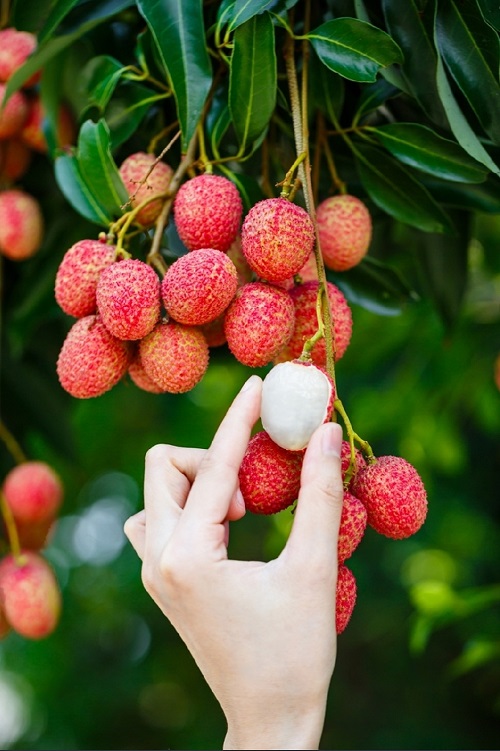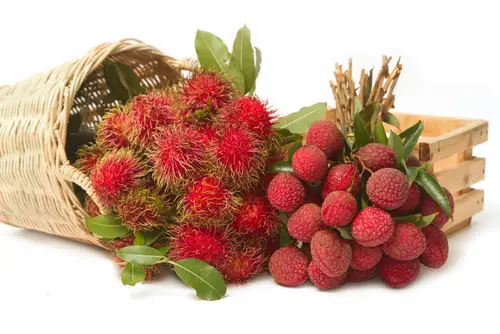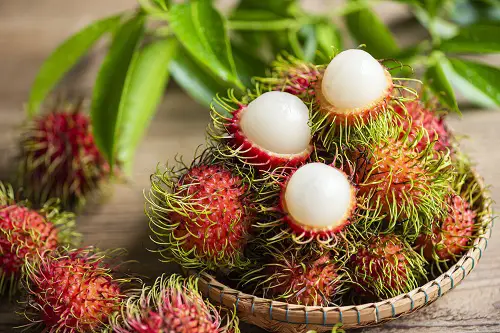Lychee vs. Rambutan—Do you know their differences? We’ll share everything about their taste, texture, and a whole lot more in this guide!
These two tropical delights have a lot in common! Don’t let their sweet, juicy taste and similar appearances trick you; there are a lot of differences between them. Stay tuned for Lychee vs. Rambutan.
What is Lychee?

Lychees (Litchi chinensis) are native to Southern China and grow on tall trees. These trees can easily reach a height of 40 feet and have a dense canopy of shiny leaves and small flowers.
These trees produce Lychees in summer, which are basically small, round berries and have a tough, red or pink outer skin with sweet, translucent flesh inside. The flesh also gives off a floral tinge when you eat it.
What Does Lychee Taste Like?
What is Rambutan?

Rambutan (Nephelium lappaceum) is a tropical fruit from Southeast Asia and is commonly found in India, Thailand, Indonesia, and the Philippines.
Rambutan has a hairy red or yellow exterior. These fruits grow in clusters and are about the size of a golf ball. Inside, it has a juicy, white flesh and a pit. You can eat it raw or even make juices or smoothies with it, but the pit is inedible.
Similarities Between Lychee and Rambutan
Both Lychee and Rambutans belong to the same family (Sapindaceae) and can be enjoyed fresh by peeling away the outer skins. They’re also made into desserts and juices and are sweet in taste. The fruits also have similar health benefits and are high in antioxidants, vitamin C, fiber, and hydration, and are low in calories.
Differences Between Lychee and Rambutan?
Despite the similarities, there are a lot of differences between the two, as well.
1. Origin
Lychees come from the southern provinces of China (Fujian and Guangdong). The first records of the fruit date back to the Tang Dynasty (618-907 AD).
On the other hand, Rambutan comes from southeast Asia, particularly the Malay peninsula.
2. Appearance
The fruits might be similar in shape but Lychees have a rough outer skin with small bumps that you can feel with your fingers.
Rambutans are also a bit rough on the outside but they don’t have bumps, they have long, spiky hair.
3. Taste
Lychees are sweet and have a crispy flesh. They also have a floral aroma that will remind you of mangosteen or a watermelon.
Rambutans are creamy but don’t give off any floral aroma or hints, but they are a bit acidic, like grapes and dragon fruits.
4. Fruit Texture
Even the flesh of Lychees and Rambutans is different. Lychees have firm flesh, but that of a Rambutan is creamier and softer.
5. Size
Lychees are smaller than Rambutans. As we told you above, Rambutans are roughly the size of a golf ball (7 by 5 cm), but Lychees are smaller (5 by 4 cm).
How to Eat Lychee and Rambutan
Lychee and Rambutan are both easy to eat and can be enjoyed in many different ways.
- Raw: You can eat both of these raw, straight from the tree. Just peel off their skin and bite into them. Be careful though, they both have a large seed in the center that’s not edible.
- Canned: You’ll also find these canned as syrup and you can relish them as a sweet snack or as a jam.
- Juices and Smoothies: They can also be made into juices or smoothies for a refreshing drink.
- Cocktails: The sweet and fruity flavor of both Lychees and Rambutans makes them popular in martinis and margaritas.
- Desserts: Why not add them to fruit salads, desserts, ice creams, or even cakes? They add a lovely, rich flavor.




Thank you for the informative article. I have only ever tasted Rambutans from the grocery store. But we do currently have 2 Lychee trees in growing our yard and agree that they are delicious. We recently purchased a Longan tree, which is in the same family as Lychees and Rambutans. It is still small, so it hasn’t fruited yet. Will have to wait and see if they are as tasty as the others.